Consider wet and electric systems for renovations, hi-tech controls and introduce the concept of Underfloor heating (UFH) earlier in the design process.
While the popularity of radiator and towel rails are conspicuous, by their very nature of adorning walls, the same cannot be said for under floor heating (UFH).
The uptake in UFH engineering technology, since it is installed below the floorboards can literally go unnoticed.
Sponsored Video
However, industry experts say the market has grown over the past two years.
Sales director of Vogue (UK) Steve Birch comments: “I’m delighted to say that there has been a growing level of interest in electric underfloor heating over the past few years.”
His view is re-iterated for the wet UFH sector, as product manager of Purmo Underfloor Heating Michelle Taylor adds: “Underfloor heating sales have really grown over the past two years, especially in the retrofit market.”
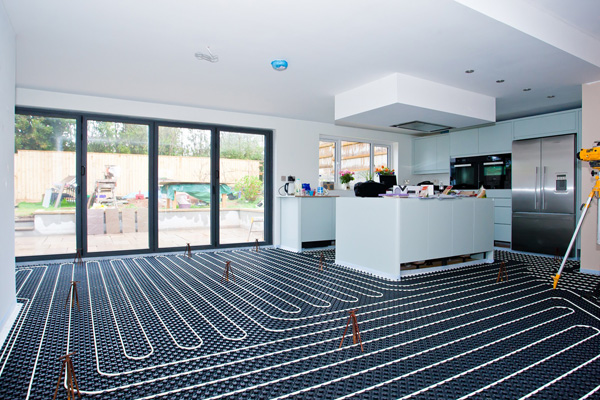
Warm water underfloor heating, LowProMax, measures 15mm high and can be retrofitted, as floor coverings can be laid directly on top. It comes with design drawings, from wiring and zoning, through to CAD tube layouts as standard
Working together
Interestingly, UFH can happily co-exist with the trend for designer radiators and towel rails, as Michelle Taylor of Purmo Underfloor Heating points out:
“It doesn’t have to be a case of either/or; the two forms of heating have different advantages. Underfloor heating is unobtrusive… Designer radiators, in contrast, can make a statement, offer larger outputs and create a feeling of style within a room.”
However, UFH can also work in isolation.
While consumers may opt to have a radiator or towel rail to warm towels in the bathroom, if an area has limited wall space UFH may be preferable.
Layout flexibility
It is this flexibility of planning, which helps bring UFH into its own and enables designers to create a comfortable environment with few layout restrictions.
Steve Birch of Vogue (UK) explains: “When used as the main source of heating, UFH makes the layout of the room far easier to plan, as it eliminates the need to think about where the radiator can be installed and how furniture should be positioned.”
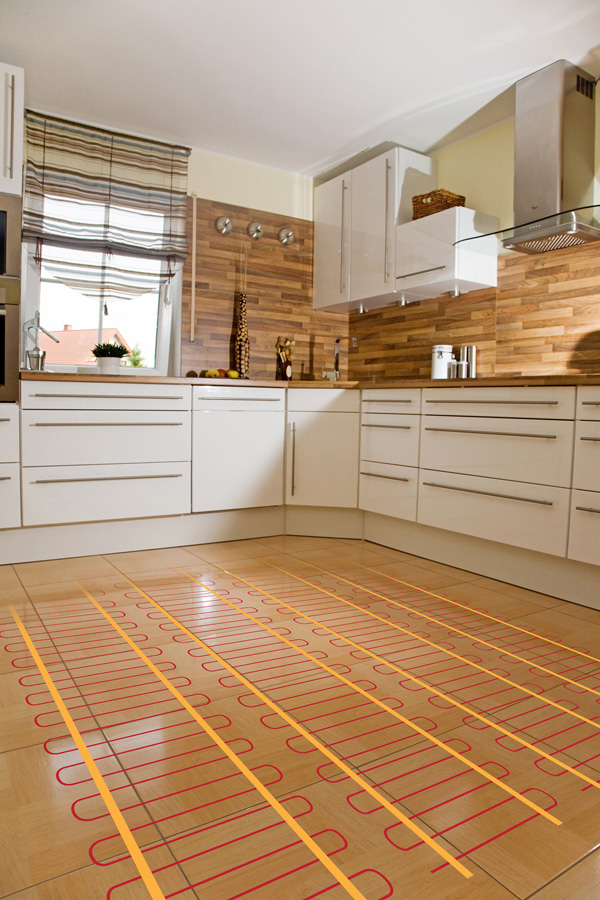
The Vogue (UK) UFH kit includes a heating matt, floor sensor and digital touch screen timer and thermostat. It can be used for areas from 1sqm to 12sqm and comes with a 15-year guarantee
More energy efficient
In addition, UFH can claim to have a more even heat distribution than a direct radiator source and experts even say it can be more energy efficient.
Steve Birch points out: “Unlike the heat that is distributed from a radiator source, underfloor heating provides a more even, constant and rapid distribution as the heat rises as opposed to being circulated around the room.”
He continues: “Underfloor heating can also be fitted in just one room or throughout the whole home and again this offers a significant advantage”
“Each underfloor system acts independently and with this in mind, you are able to easily adjust the temperature of each room, as opposed to having to set one temperature throughout the whole home: energy efficient!”

The MyHeating App with SmartGeo and EasySwitch can be used with the 4iE Smart WiFi Thermostat. SmartGeo uses location services built into smartphones to learn what rooms are being used and when for more efficient heating, while EasySwitch automatically switches the account to the best available tariff each year
Technological developments
The heated flooring concept may be nothing new – in fact it dates as back as far as 5,000 BC in China and Roman times in the UK – but there have been recent developments in wet systems and controls for all UFH.
Purmo Microboard which features grooves for hydronic pipework measures 18mm thick and has been designed to lay over most flooring and be integrated with existing heating.
It now sees wet UFH commonly used in newbuilds and selfbuilds to be used in renovations.
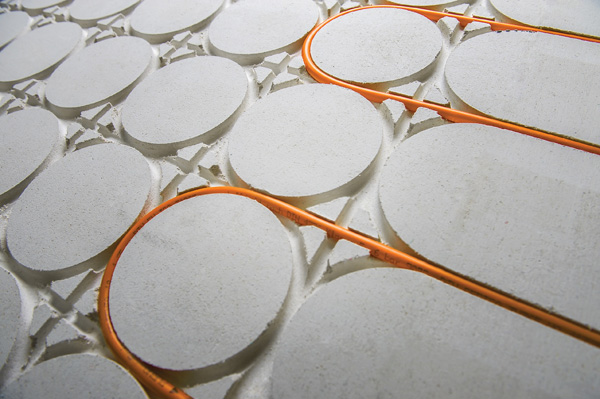
Measuring 18mm deep, Microboard features grooves to fit hydronic pipework and comes with a choice of two panel types to fit over most floor types. It can be integrated with an existing heating system, so can be used for renovations
While smart thermostatic controls has seen the introduction of apps, to not only control remotely, but to sense geolocations reminding the user to turn the heating on/off when leaving the house and also learn patterns of use.
But director of Ceramique International Peter Vann says not all technology changes have been beneficial to the market, with cheaper imports hailing from (ironically) Asia.
He exclaims: “The most recent change in terms of technology has been the increase in lower quality and more basic products from the Far East flooding the UK market.”
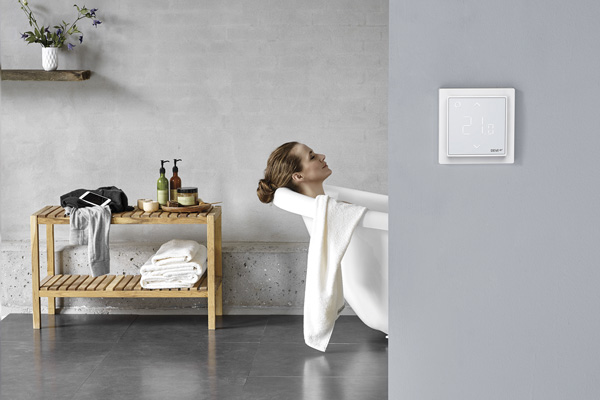
The Devi Reg Smart thermostat and DeviSmart App allow users to operate their underfloor heating remotely and allows installation from a smartphone. It features holiday settings, economy mode and a weekly schedule and can be used with almost all electrical floor heating frames
Flawed knowledge
With such an established market, then, bathroom and kitchen retailers and designers must surely already be knowledgeable on the latest UFH.
“Putting it bluntly, no. There are plenty of gaps in knowledge that can be readily plugged”, retorts Peter Vann of Ceramique International.
He explains: “UFH isn’t really a technical product but retailers still struggle when it comes to understanding how to convey to a consumer the difference between convected and radiant heat. It’s no surprise that many are missing the opportunity to make the easiest add-on sale in the world.”
He offers the advice to not only have a showroom display fitted with working UFH but to introduce it early in the sales process:
“Kitchen and bathroom retailers are generally scared to include UFH in processes for fear of losing the main sale. As such, it becomes a product that is tagged onto the end of a sale”
“We see this as a big mistake because, by definition, UFH should be included from the start so that you can build on top of, both from a sales and installation point of view.”
So get up-to-speed with developments in electrical and wet systems, together with controls to make sure UFH heating sales aren’t flawed.
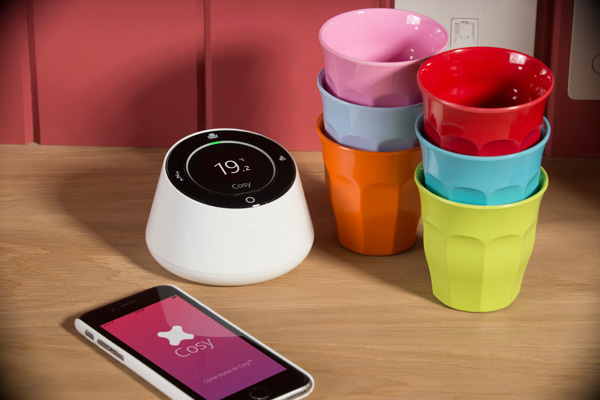
Designed for new build properties Cosy 3 can work with a twin zone heating system, and has a hot water control suitable for homes with tanks. The thermostat display is offered in White, Premium Wood or Black Acrylic



